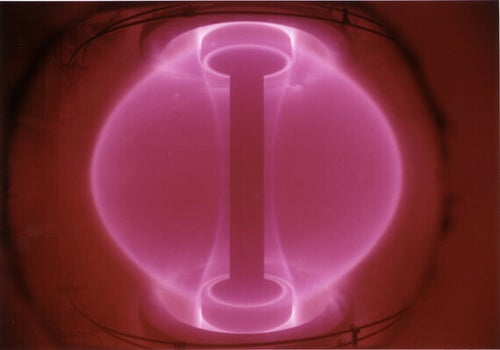

Tokamak Energy
The world needs abundant, clean energy. Nuclear fusion - with no CO2 emissions, no risk of meltdown and no long-lived radioactive waste - is the obvious solution, but it is very hard to achieve.
The challenge is that fusion only happens in stars, where the huge gravitational force creates pressures and temperatures so intense that usually repulsive particles will collide and fuse; hence "fusion". On Earth we need to create similar conditions, holding a hot, electrically-charged plasma at high enough pressure for long enough for fusion reactions to occur. The scientific and engineering challenges behind putting a star in a box are large, to say the least. Without proper confinement of the plasma, the reaction would stop. The plasma must be isolated from the walls of the reactor - a feat that can be performed most effectively by magnets. The most advanced machine for this purpose is the 'tokamak'.
The magnetic fusion approach uses strong magnetic fields to pressurize and trap the hot plasma fuel. Within magnetic fusion there are many different configurations of magnets, but the best performance, by far, has been achieved in ring-doughnut-shaped tokamak devices, the simplest shape that has no open-ended magnetic field lines. The JET tokamak at Culham Laboratory achieved 16MW of fusion power in 1997 with 24MW of input power.
However, progress since then has slowed because the successor device, ITER, reached such gargantuan proportions that it has succumbed to numerous delays. The establishment fusion timeline is measured in many decades, not years. Yet in view of the COP21 target of keeping global temperature rises below 2C by 2050, promising methods of reducing carbon emissions from energy generation should be prioritised as a matter of urgency.
This urgency and desire for change, combined with a frustration with the sluggishness of the mainstream fusion programme (and an awareness of the inherent difficulties of such a big project as ITER), has produced a new focus on smaller reactors that can be developed quickly. The possibility of a small, modular way to fusion has fired the imagination of inventors, innovators and now investors.
In the past few years, small modular fusion has gained the attention of high profile technology backers such as Jeff Bezos, founder of Amazon, Paul Allen of Microsoft and Peter Thiel, co-founder of PayPal. Together they have invested many tens of millions into private fusion ventures in the US. Further investments come from a wide array of venture capital funds, sovereign wealth funds and angel investors. This has enabled complex fusion engineering to be developed quicker than it has for years; using a smaller design makes it easier to build up momentum and develop technologies faster.
Tokamak Energy is benefitting from this new era of enthusiasm for fusion, raising well over £10 million to date, mainly from private investors. Working with experienced consultants and international collaborators, Tokamak Energy is developing designs that reduce the scale of the tokamak - the most studied and top-performing reactor design - while maintaining its ability to produce power.
Within the class of tokamaks there are two main shape choices - a conventional donut shape such as JET or an apple-shaped 'spherical' tokamak, described recently by Dan Clery in Science Magazine as "the new kid on the block". This latter form is the route Tokamak Energy is pursuing.
The primary advantages of the spherical tokamak are due to its squashed-up shape - it is inherently compact and is more efficient. The increase in efficiency comes from greater use of the strongest magnetic field at the centre of tokamaks. But its limitation has always been the tricky engineering resulting from a lack of space in the centre of the machine.
Recently, however, a solution has been found. New, thin tapes of high temperature superconducting (HTS) material have been developed that, when wound into coils to create magnets, are able to generate exceptionally strong magnetic fields whilst taking up relatively little space. Together with the spherical tokamak design, these can be used to create a compact yet effective reactor.
Our approach, therefore, is to increase the magnetic field in more compact devices instead of building ever larger tokamaks with huge costs and long timescales. This turns the pursuit of fusion energy from a big moonshot to a series of engineering challenges: can we get to fusion temperatures in a compact device? Can we get to fusion breakeven in a compact device? Can we get sufficiently beyond breakeven to produce electricity for the first time? And, can we go on from that to build reliable, economic, fusion power plants?
The increasing number of start-ups coming onto the scene is encouraging. A competitive race, driven by private investment, can only be good for the progress of fusion. A concerted effort towards fusion energy is the best way to solve the pressing need to reduce greenhouse gas emissions and ensure a supply of safe, clean energy long into the future. The global impact of electricity from fusion will be huge. We must try harder to get there quicker. Thinking smaller is the key.
http://www.tokamakenergy.co.uk/